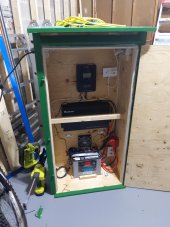Red Squirrel
New Member
- Joined
- Jan 1, 2020
- Messages
- 114
I'm building a portable solar power station, it mostly all works except I have not implemented the cut off switch yet because I was waiting for it to arrive in the mail. I want to be able to turn the entire system off at the battery when not in use otherwise the charge controller will stay on and use power.
I get huge sparks when I do connect the battery manually so it seems the charge controller has a pretty serious capacitor. Inverter does not seem as bad. But normally I am basically connecting both at same time.
Now my question is, once I do add the switch am I ok to have just the switch or should I still have a resistor in parallel with the switch, with it's own switch? Would the switch spark internally damaging the contacts or are they normally designed to actually handle that? Having the resistor was my original intent, but it's proving challenging to physically get this wired up properly and I'm thinking maybe I'm doing all this for nothing and I can just forget it altogether.
This is the switch I went with: https://www.modernoutpost.com/product/blue-sea-6006-m-series-battery-switch/
The system is 12v with a single 79ah AGM battery and 3kw inverter and Renogy charge controller.
I get huge sparks when I do connect the battery manually so it seems the charge controller has a pretty serious capacitor. Inverter does not seem as bad. But normally I am basically connecting both at same time.
Now my question is, once I do add the switch am I ok to have just the switch or should I still have a resistor in parallel with the switch, with it's own switch? Would the switch spark internally damaging the contacts or are they normally designed to actually handle that? Having the resistor was my original intent, but it's proving challenging to physically get this wired up properly and I'm thinking maybe I'm doing all this for nothing and I can just forget it altogether.
This is the switch I went with: https://www.modernoutpost.com/product/blue-sea-6006-m-series-battery-switch/
The system is 12v with a single 79ah AGM battery and 3kw inverter and Renogy charge controller.




